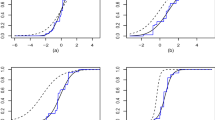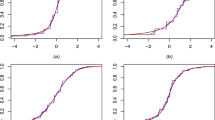Abstract
Doubly robust (DR) methods that employ both the propensity score and outcome models are widely used to estimate the causal effect of a treatment and generally outperform those methods only using the propensity score or the outcome model. However, without appropriately chosen the working models, DR estimators may substantially lose efficiency. In this paper, based on the augmented inverse probability weighting procedure, we derive a new estimating equation for the causal effect by the strategy of combining estimating equations. The resulting estimator by solving the new estimating equation retains doubly robust and can improve the efficiency under the misspecification of conditional mean working model. We further show the large sample properties of the proposed estimator under some regularity conditions. Through simulation experiments and a real data analysis, we illustrate that the proposed method is competitive with its competitors, which is in line with those implied by the asymptotic theory.
Similar content being viewed by others
References
Austin, P.C.: The performance of different propensity score methods for estimating marginal hazard ratios. Stat. Med. 32, 2837–2849 (2013)
Bang, H., Robins, J.M.: Doubly robust estimation in missing data and causal inference models. Biometrics 61, 962–973 (2005)
Benkeser, D., Carone, M., Laan, M.J.V.D., Gilbert, P.B.: Doubly robust nonparametric inference on the average treatment effect. Biometrika 104, 863–880 (2017)
Cao, W., Tsiatis, A.A., Davidian, M.: Improving efficiency and robustness of the doubly robust estimator for a population mean with incomplete data. Biometrika 96, 723–734 (2009)
Cattaneo, M.D.: Efficient semiparametric estimation of multi-valued treatment effects under ignorability. J. Econom. 155, 138–154 (2010)
Dehejia, R.H., Wahba, S.: Causal effects in nonexperimental studies: Reevaluating the evaluation of training programs. J. Am. Stat. Assoc. 94, 1053–1062 (1999)
Firpo, S.: Efficient semiparametric estimation of quantile treatment effects. Econometrica 75, 259–276 (2007)
Hirano, K., Imbens, G.W., Ridder, G.: Efficient estimation of average treatment effects using the estimated propensity score. Econometrica 71, 1161–1189 (2003)
Imai, K., Ratkovic, M.: Covariate balancing propensity score. J. R. Stat. Soc. Ser. B-Stat. Methodol. 76, 243–263 (2014)
Kang, J., Schafer, J.: Demystifying double robustness: A comparison of alternative strategies for estimating a population mean from incomplete data. Stat. Sci. 22, 523–539 (2007)
LaLonde, R.J.: Evaluating the econometric evaluations of training programs with experimental data. Am. Econ. Rev. 76, 604–620 (1986)
Linden, A., Adams, J.L.: Using propensity score-based weighting in the evaluation of health management programme effectiveness. J. Eval. Clin. Pract. 16, 175–179 (2010)
Lunceford, J.K., Davidian, M.: Stratification and weighting via the propensity score in estimation of causal treatment effects: a comparative study. Stat. Med. 23, 2937–2960 (2004)
Newey, W.K., McFadden, D.: Large sample estimation and hypothesis testing. In: Engle, R., McFadden, D. (eds.) Handbook of Econometrics, pp. 2111–2245. Elsevier, Amsterdam (1994)
Neyman, J.: On the application of probability theory to agricultural experiments. Essay on principles, section 9. translation of original 1923 paper, which appeared in roczniki nauk rolniczych. Stat. Sci. 5, 465–472 (1990)
Qin, J., Zhang, B., Leung, D.H.: Efficient augmented inverse probability weighted estimation in missing data problems. J. Bus. Econ. Stat. 35, 86–97 (2017)
Ridgeway, G., McCaffrey, D.F.: Comment: Demystifying double robustness: a comparison of alternative strategies for estimating a population mean from incomplete data. Stat. Sci. 22, 540–543 (2007)
Robins, J., Rotnitzky, A., Zhao, L.: Estimation of regression coefficients when some regressors are not always observed. J. Am. Stat. Assoc. 89, 846–866 (1994)
Robins, J.M.: Association, causation, and marginal structural models. Synthese 121, 151–179 (1999)
Robins, J.M., Hernan, M.A., Brumback, B.: Marginal structural models and causal inference in epidemiology. Epidemiology 11, 550–560 (2000)
Robins, J.M., Rotnitzky, A., Zhao, L.P.: Analysis of semiparametric regression models for repeated outcomes in the presence of missing data. J. Am. Stat. Assoc. 90, 106–121 (1995)
Rosenbaum, P.R., Rubin, D.B.: The central role of the propensity score in observational studies for causal effects. Biometrika 70, 41–55 (1983)
Rubin, D.B.: Estimating causal effects of treatments in randomized and nonrandomized studies. J. Educ. Psychol. 66, 688–701 (1974)
Rubin, D.B.: Randomization analysis of experimental data: the fisher randomization test comment. J. Am. Stat. Assoc. 75, 591–593 (1980)
Rubin, D.B., van der Laan, M.J.: Empirical efficiency maximization: improved locally efficient covariate adjustment in randomized experiments and survival analysis. Int. J. Biostat. 4, 1–40 (2008)
Scharfstein, D.O., Rotnitzky, A., Robins, J.M.: Adjusting for nonignorable drop-out using semiparametric nonresponse models. J. Am. Stat. Assoc. 94, 1096–1120 (1999)
Smith, J.A., Todd, P.E.: Does matching overcome LaLondes critique of nonexperimental estimators? J. Econom. 125, 305–353 (2005)
Tan, Z.: Comment: Understanding OR. PS and DR. Stat. Sci. 22, 560–568 (2007)
Tan, Z.: Bounded, efficient and doubly robust estimation with inverse weighting. Biometrika 97, 661–682 (2010)
Tsiatis, A.: Semiparametric Theory and Missing Data. Springer, New York (2006)
Uysal, S.D.: Doubly robust estimation of causal effects with multivalued treatments: an application to the returns to schooling. J. Appl. Econom. 30, 763–786 (2015)
van der Laan, M.J., Rose, S.: Targeted Learning: Causal Inference for Observational and Experimental Data. Springer, Berlin (2011)
Vansteelandt, S., Bekaert, M., Claeskens, G.: On model selection and model misspecification in causal inference. Stat. Methods Med. Res. 21, 7–30 (2012)
Vermeulen, K., Vansteelandt, S.: Bias-reduced doubly robust estimation. J. Am. Stat. Assoc. 110, 1024–1036 (2015)
Vermeulen, K., Vansteelandt, S.: Data-adaptive bias-reduced doubly robust estimation. Int. J. Biostat. 12, 253–282 (2016)
Wooldridge, J.M.: Inverse probability weighted estimation for general missing data problems. J. Econom. 141, 1281–1301 (2007)
Acknowledgements
The authors are grateful to the editor, the field editor and the two anonymous referees for the constructive comments and suggestions that led to significant improvement of an early manuscript. The researches of Shaojie Wei and Zhongzhan Zhang were partly supported by the National Natural Science Foundation of China (No. 11771032 and No.11971045) and Natural Science Foundation of Bei**g (No. 1202001). Gaorong Li’s research was supported by the National Natural Science Foundation of China (No. 11871001, No. 12131006 and No. 11971001) and the Fundamental Research Funds for the Central Universities (2019NTSS18).
Author information
Authors and Affiliations
Corresponding author
Rights and permissions
About this article
Cite this article
Wei, S., Li, G. & Zhang, Z. An Alternative Doubly Robust Estimation in Causal Inference Model. Commun. Math. Stat. (2022). https://doi.org/10.1007/s40304-022-00308-4
Received:
Revised:
Accepted:
Published:
DOI: https://doi.org/10.1007/s40304-022-00308-4
Keywords
- Average treatment effect
- Causal effect
- Doubly robust method
- Estimating equation
- Inverse probability weighting
- Semiparametric efficiency




